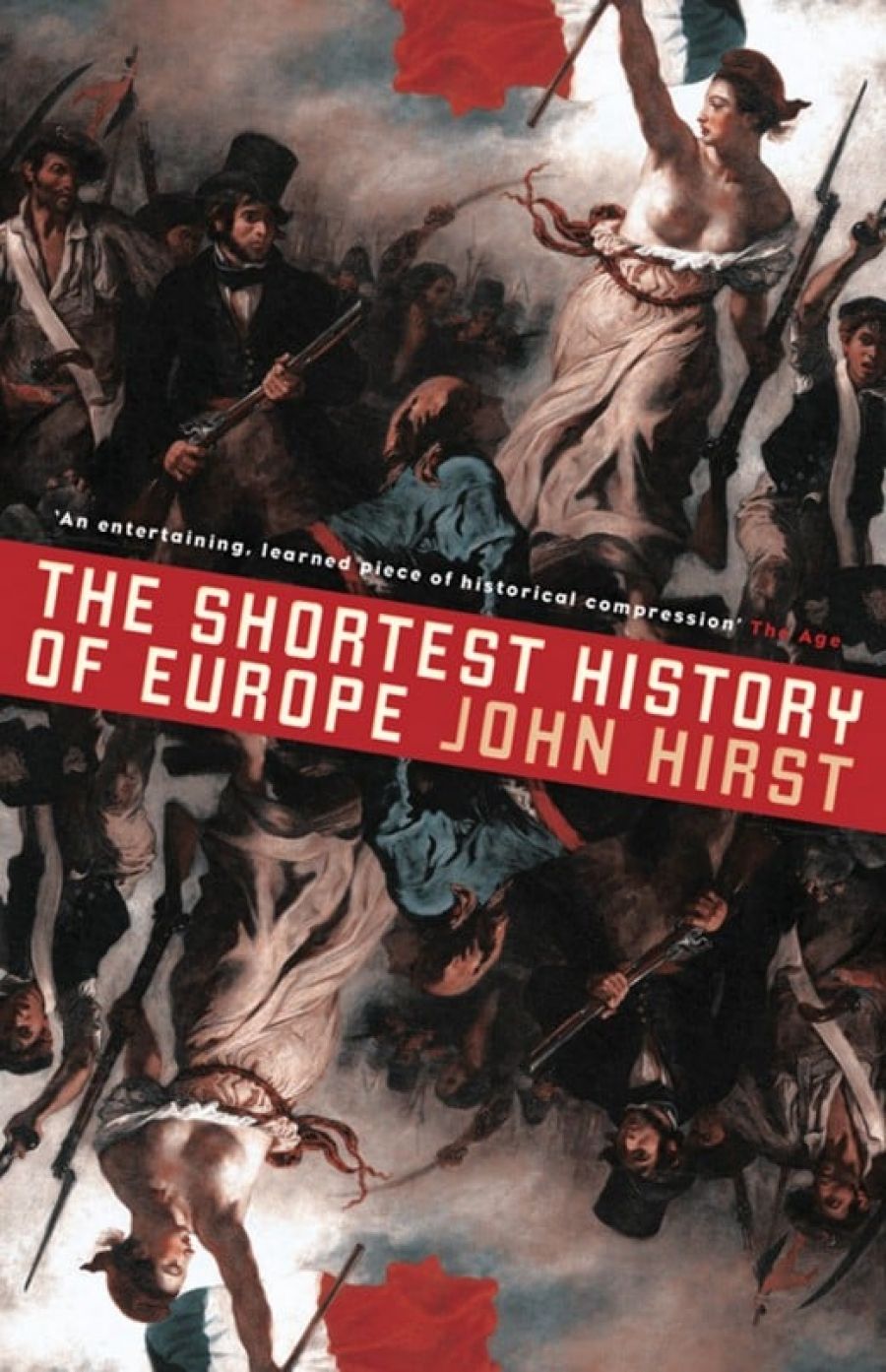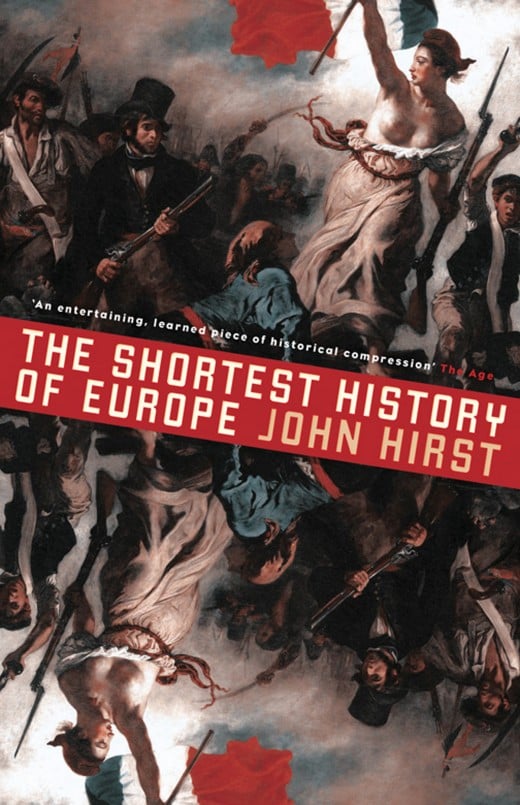
- Free Article: No
- Contents Category: History
- Review Article: Yes
- Article Title: Plato to NATO
- Online Only: No
- Custom Highlight Text:
The opening sentence of Norman Davies’ blockbuster Europe: A History (1996) notes that ‘History can be written at any magnification’. Yet the superlative asserted in the title of John Hirst’s latest book does bring one up, well, short. Its claim is plainly contestable – how about ‘Plato to NATO’ (the irreverent shorthand for once-fashionable US undergraduate ‘Western Civ.’ survey courses)? Moreover, Hirst makes no pretence of giving us Europe from go to whoa. Commencing with the ‘Ancient Greeks’ (omitting Minoans and Myceneans), he concludes around 1800 with the French Revolution and Napoleon, because the lecture course at La Trobe University from which his book derives went no further. These lectures were first offered ‘to students in Australia who had had too much Australian history and knew too little about the civilisation of which they are a part’. This is a remarkable statement from a distinguished historian of Australia, even granted the growing recognition that what usually passes for ‘Australian history’ cannot in and of itself meet all the cultural, educational and intellectual needs of Australian students.
- Book 1 Title: The Shortest History of Europe
- Book 1 Biblio: Black Inc. $24.95 pb, 149 pp
- Book 1 Cover Small (400 x 600):

To an early modernist (trade jargon for anyone professing a period or topic between c.1400–1800) like myself, Hirst’s chronological foreshortening seems unproblematic. Yet paying customers might well feel hard done by when they discover that this history of Europe omits the last two hundred years – imperialism, world wars, great dictators, and all. Perhaps they will be mollified by Hirst’s claim that ‘if my approach works you’ll recognise the world we now live in, whose lineaments were laid down long ago’. Establishing continuities between fifth-century Athens or seventeenth-century England and us – that is, the inhabitants of early twenty-first-century European Australia – need not deny the impact of more recent change and innovation.
Hirst’s method – for which alone he claims originality – is straightforward enough. His first two chapters comprise the ‘shortest history’, sketching the key components of ‘Europe Classical and Medieval’ and ‘Europe Modern’ in forty pages. These are followed by a brilliant nutshell characterisation of ‘The Classic Feeling’: what was distinctive and significant about the writings of the Greeks and Romans, which have played so vital a role in Western culture until something like the day before yesterday. This ‘interlude’ introduces a series of six more detailed discussions, of medieval conquests and migrations, forms of government (from Athenian participatory to French revolutionary and totalitarian democracy), church–state (or emperor–pope) relations, European languages (especially Latin, which ‘like the idea of the Holy Roman Empire ... has been a long time dying’), and the material living conditions of peasants and workers. A brief conclusion attributes Europe’s dynamism and precocious modernity to the tensions contained within this unique cultural, intellectual and institutional amalgam. So we return to the key theme of the first chapter, where European civilisation is presented as an ‘unlikely mixture’ of three diverse elements: Greek and Roman learning (the world is simple, logical and mathematical); Christianity (the world is evil, and Christ the only saviour), and the barbarian German warrior’s credo (fighting is fun).
Such a compressed and schematic outline inevitably invites quibbles, general and particular: isn’t ‘civilisation’ the product of material circumstances, not ideas alone? Surely Spartans and Romans were also pretty keen on fighting. Why so little on Russia, Scandinavia, Spain and the Balkans, let alone the Atlantic and Mediterranean? And William the Conqueror was not quite England’s last invader (that honour accrued to Dutch William in 1688), while the idea of progress antedates the Scientific Revolution, being inherent in Christian doctrines of progressive revelation. But these are mere cavils, far outweighed by Hirst’s positive achievement.
Crisp, lucid and evocative prose addresses the reader directly, with generally unpatronising assurance and numerous personal touches. The balance of analysis and description, generalisation and specific instance, is beautifully maintained, with a splendid store of unhackneyed anecdote, analogy and example. Thus we learn that the inspection of guards of honour by contemporary heads of state is ‘a carry-over from an early medieval practice when the king was really scrutinising the soldiers he had been sent [by his feudal tenants-in-chief] and saying to himself: what sort of rubbish have they sent this time?’ The transition from Rome’s monarchy to republic, and its unremitting code of honour, are memorably expounded via Livy’s graphic account of the rape of Lucretia and the bloody revenge exacted by her brother Brutus, with a link to David’s paintings celebrating manly republican virtue on the eve of the French Revolution. Conflicts between medieval popes and secular rulers evoke an imaginary Toyota-like corporation whose local executives are appointed by Australian politicians, according to their local agendas. The text comes reinforced with an abundance of ingenious supporting diagrams, figures, maps and tables, plus a selection of apposite (if rather tiny) black-and-white images, including a particularly effective juxtaposition of the human form as rendered respectively by Praxiteles, the anonymous sculptor of the cathedral doors at Hildesheim, and Michelangelo.
When the young John Hirst left Adelaide for La Trobe University in the late 1960s, he joined what would become for a while the largest and liveliest history department in Australia. This memorable survey is among the last fruits of that now sadly diminished seed-bed. Will we ever see its like again?


Comments powered by CComment